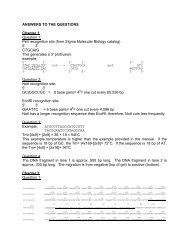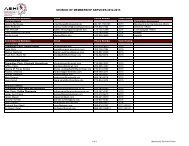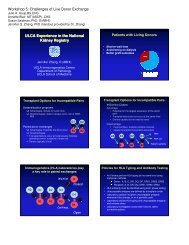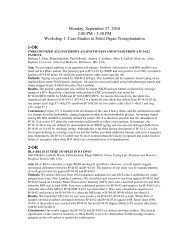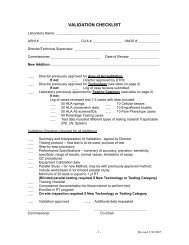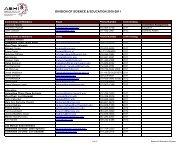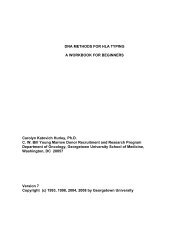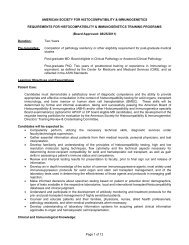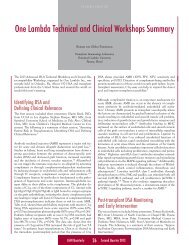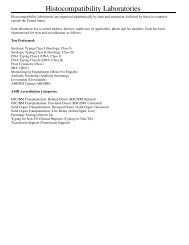Advanced Flow Workshop Shumway Murphey
Advanced Flow Workshop Shumway Murphey
Advanced Flow Workshop Shumway Murphey
You also want an ePaper? Increase the reach of your titles
YUMPU automatically turns print PDFs into web optimized ePapers that Google loves.
<strong>Workshop</strong> 2: <strong>Advanced</strong> <strong>Flow</strong> <strong>Workshop</strong>-<br />
Wayne <strong>Shumway</strong>, CHT, CHS and<br />
Cathi <strong>Murphey</strong>, MT(ASCP), CHS, BLM<br />
XM: DONOR + RECIPIENT SELECTION<br />
Best donor choice = least<br />
fluorescence from<br />
secondary antibody<br />
3<br />
detected.<br />
FCXM #1<br />
3<br />
The quantity of signal<br />
XM:<br />
above background is of<br />
- Bkgnd:<br />
36<br />
200% of background<br />
significance (because it<br />
Aby:<br />
3<br />
(77 ch. . Shift)<br />
directly reflects the<br />
Y<br />
number of patient<br />
FCXM #2<br />
1<br />
antibodies bound), the<br />
XM:<br />
1<br />
proportion of background<br />
- Bkgnd:<br />
12<br />
200% of background<br />
is IRRELEVANT*!<br />
Aby:<br />
1 (77 ch. . Shift)<br />
*with regard to the number of antibodies present<br />
Y<br />
Y<br />
Y<br />
Y<br />
Y<br />
Y<br />
Y<br />
Channel Shifts and the Illusion of Increased<br />
Sensitivity When Using Pronase<br />
Y Y<br />
The same number of<br />
Untreated B Cells<br />
antibody molecules<br />
XM:<br />
binding against a lower<br />
- Bkgnd:<br />
background produce a<br />
36<br />
greater channel shift – Aby:<br />
3<br />
but remain the same<br />
77 ch. . Shift<br />
number of antibody<br />
molecules!<br />
Pronase Treated B Cells<br />
Linear data reflects the<br />
XM:<br />
true quantity above<br />
- Bkgnd:<br />
14<br />
background – a value<br />
Aby:<br />
3<br />
that is independent of<br />
154 ch. . Shift<br />
the background.<br />
Y Y<br />
Y<br />
Y<br />
Y<br />
3<br />
Y<br />
Y<br />
1<br />
Y<br />
Y<br />
Y<br />
3<br />
background<br />
1<br />
background<br />
Relative Linear Values (RLV) are frequently referred to as MFI (Median<br />
or Mean Fluorescence Intensity) values. It is these RLV / MFI values<br />
that are “numbers” in the conventional sense (NOT the channel<br />
values!), they have simply been plotted on a log scale. Events with an<br />
MFI value of 600 are twice as bright as those with an MFI of 300 (the<br />
expected, conventional, “linear” relationship). HOWEVER, if an event<br />
reads at channel 600, an event half as bright will read at channel 523.<br />
So how do we convert the channels to<br />
the “numbers”?<br />
CHANNEL VALUE<br />
Calculate “R” = the<br />
channel value divided<br />
by channels per decade<br />
512<br />
512/256 = 2<br />
End of 1 st decade<br />
End of 2 nd decade<br />
End of 3 rd decade<br />
256 512 300 768 1024<br />
200 400 600 600 800<br />
End of 4 th decade<br />
1000<br />
10 R = RELATIVE<br />
LINEAR VALUE<br />
(RLV – aka MFI)<br />
10 2 = 100<br />
1<br />
RLV<br />
10 100 1000<br />
Fluorescence Intensity<br />
10,000<br />
W H E N I N L O G “M M O D E” E :<br />
CHANNEL VALUES<br />
BD = “Log Data”<br />
Coulter = “Linear Data”<br />
RELATIVE LINEAR VALUES<br />
BD = “Linear Data”<br />
Coulter = “Log Data”<br />
End of 1 st decade End of 2 nd decade End of 3 rd decade<br />
End of 4 th decade<br />
256 512 768 1024<br />
RELATIVE LINEAR VALUE<br />
is a much better term than<br />
Median Fluorescence Intensity<br />
1<br />
RLV<br />
200 400<br />
600 800 1000<br />
10 100 1000 10,000<br />
5



